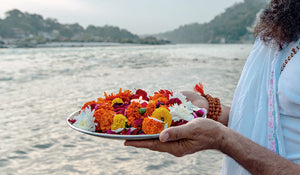Shrouds and their symbolism - Antyesti
Shrouding the dead has acquired a rich amount of symbolism throughout history. In various cultures and rituals, this act has been interpreted in its own way, leading to many different meanings. Every week we share a story from the rich cultural history of the shroud.
Antyesti
In Hindu tradition, the family of the deceased must perform post-mortem care themselves. This involves washing the body and placing it in a shroud for the service. If the deceased is a man or a widow, a white shroud is used. Married women are dressed in their wedding dress and wrapped in an orange shroud. Although the physical body dies, it is believed that the individual soul has no beginning or end. It can find another body through reincarnation and eventually merge with Brahman, 'oneness'. Antyesti is a compound word in Sanskrit, consisting of antya and isti, 'last' and 'sacrifice'. This final 'sacrifice' is completed with the cremation of the body. The idea behind this ceremony comes from Vedic traditions where it was believed that Agni, the fire god and messenger between gods and humans, would accompany the soul of the deceased.



